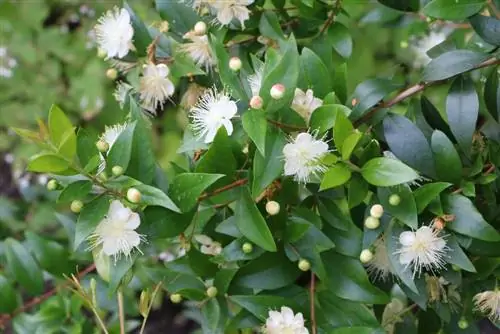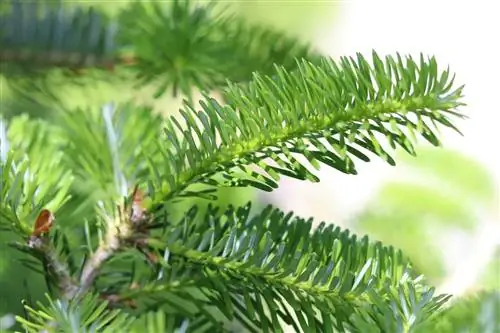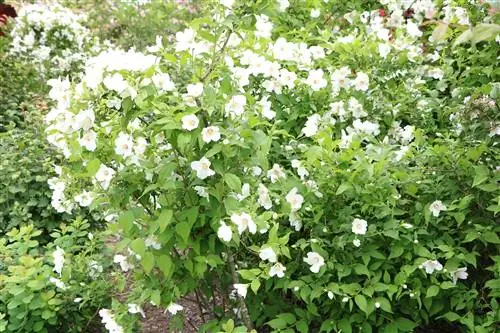- Author admin [email protected].
- Public 2023-12-17 03:39.
- Last modified 2025-01-24 12:45.
There are some properties where the usual hedge is not the best border. There are plots of land that are simply so large that edging them with specimens of the usual hedge plants would immediately lead to impoverishment.
There are properties that should look as natural as possible; perhaps the selected wood should simply grow freely in some locations and be able to withstand topiary in other areas. There are properties where the hedge-like border has to fulfill an additional task, e.g. B. to fortify a slope. In all of these cases, a hedge design with hedge spruce or hedge myrtle is possible:
The spruce for the hedge
Spruces are conifers, which doesn't really qualify them as hedge plants. Conifers grow differently than other shrubs; they usually branch out from a main stem and create new plant tissue, partly through meristems. Meristems grow through cell division, sometimes genetically biased to only form new cells in the upper or outer areas. What lies below and close to the trunk loses the ability to sprout again after a cut. That's why many conifers form conical shapes that are only green on the outside. This is why most conifers cannot be pruned very well; any cut that is too deep goes into the area that is no longer programmed for growth and leaves a hole in the plant forever. If the conifer has a tip meristem that is cut too vigorously, the tip will never grow any further.
Of course, not every type of conifer is equally hesitant in growth after cutting. In yews, for example, the area of the plant that sprouts again after cutting is. B. very large, other conifers sprout willingly, at least if you don't cut too deeply. This also includes the spruce trees, which sprout again reliably if they are only pruned at the ends of the branches and are encouraged to branch out through pruning. Only if you cut too deeply will they no longer grow out; holes once cut will then remain.
Spruces have other properties that make them recommended as a hedge plant. They do not place any special demands on their location, grow on moist and nutrient-poor soils and are very shade tolerant. They serve as food and habitat for some small animals, such as the pine hawkmoth, a type of butterfly whose caterpillars feed on the needles of spruce trees.
Spruce trees can be planted on any frost-free day from the beginning of autumn to the beginning of spring and from then on they must be pruned regularly if they are to take on the shape of a hedge. It is best to cut the spruce hedge after the second shoot in autumn. Since it then no longer grows much, you can get by with one cut per year. However, if the shape of the hedge requires it, it can also be cut after the first shoots in spring; you should always only cut off enough so that the remaining shoots are still green.
Native to Central Europe, the Norway spruce, Picea abies, is a fast-growing evergreen conifer that can be planted individually and in groups. It is also called red spruce (or, botanically incorrectly, red fir) because it has reddish-brown bark. The young spruce has grass-green needles that later become deep green and shiny. Red spruces thrive in almost every location; the shallow-rooted trees can grow by over 50 cm per year.
If the Norway spruce is to be planted as a hedge, 3 to 4 plants are planted per meter. Also popular with us is the blue spruce, Picea pungens glauca, which comes from North America. It is also a robust coniferous tree with bluish shimmering needles, but prefers nutrient-rich soil. The blue spruce grows around 30 cm per year and can also be grown as a hedge; 3 to 4 plants are planted per meter. Or the Serbian spruce, Picea omorika, which grows well on permeable soils and, with its straight growth, can be easily grown as a privacy hedge.
These were just a few examples from the large selection of spruces, the diverse world of spruces has growth forms available for every location and for every design wish.
The myrtle hedge
If you don't want a border to grow so high, you can use hedge myrtle to create a hedge. Here you can use the bank myrtle, Lonicera pileata, a small evergreen shrub that is resilient and frost-hardy. The slope myrtle is a strong-growing area planter that thrives in normal to dry soil, tolerates sunny and shady locations and is very well suited for stabilizing slopes. The embankment myrtle grows up to 1 meter high, can be cut back sharply and always grows vigorously, so it can also be used to create small hedges. You should plant 3 to 4 plants per meter of the bank myrtle.
Even better for creating small hedges is the hedge myrtle, Lonicera nitida Elegant, an evergreen, multi-shooting shrub that grows upright and has lush branches. The hedge myrtle can be planted in sunny to very shady locations, tolerates drought and urban climates, any normal, cultivated garden soil from acidic to alkaline, 3 to 5 plants per meter can be planted. It is a very good ground cover, but reaches heights of up to 1.5 meters. In winter it can sometimes freeze back to the ground, but then regenerates quickly.
If you want to create a hedge with bush myrtle or hedge myrtle, the most important thing is regular trimming. In this case, you have to prevent the plant from developing its own growth forms from the outset.
A hedge consists of many small branches growing close together, not of individual, strong, long shoots with small side branches, as a completely free-growing myrtle would form. In addition, it would develop powerfully in width, while when training it to become a hedge, preference is given to shoots that develop upward growth. Every branch that is longer than approx. 10 cm should therefore be cut off so that a neat little border hedge will soon develop. By the way, cutting provides you with thousands of cuttings, e.g. B. the hedge could be continued further and further (simply stick it into the ground in the desired extension direction).






